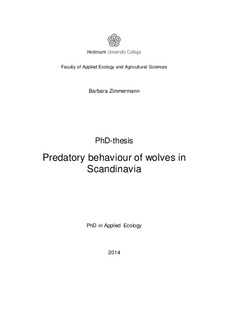| dc.contributor.author | Zimmermann, Barbara | |
| dc.date.accessioned | 2014-04-10T08:09:16Z | |
| dc.date.available | 2014-04-10T08:09:16Z | |
| dc.date.issued | 2014 | |
| dc.identifier.uri | http://hdl.handle.net/11250/194207 | |
| dc.description.abstract | The study of predatory behaviour is essential for understanding the interactions that may affect the behaviour and population dynamics of the species involved and consequent cascading ecosystem effects. In the case of large carnivores feeding on large ungulate prey, predation is strongly impacted by humans who alter the habitat of both predators and their prey, control population sizes, and compete with large carnivores for the same prey species.
The objectives of this thesis were to 1) establish a robust method to estimate kill rates of wolves (Canis lupus); 2) estimate kill rates during both summer and winter; 3) relate kill rates to prey availability in winter (functional response) and to the energetic requirements of the wolf packs; and 4) to study the impact of roads on predatory and other behaviour of wolves. To meet these objectives, the Scandinavian Wolf Research Project (SKANDULV) fitted wolves with Global Positioning System (GPS) collars and searched for kill remains on clusters of GPS-positions during defined time periods in winter and summer. Winter prey densities of cervids were assessed by spring counts of faecal pellet groups.
High variation in the spatio-temporal movement pattern of wolves in relation to kill sites made it difficult to predictably identify kill sites along the wolf trajectory without fieldwork. Consequently, field personnel checked all clusters, and in addition some single positions, to obtain robust estimates of kill rate. Human disturbance at kill sites may be one possible reason for the high variation in the handling of kills, with a relatively short handling time associated with kills located in areas with a high potential for human disturbance. During summer, wolves preferred to be at intermediate distances to roads while handling prey. This was probably the result of a trade-off between avoidance of human presence and the preference for roads while traveling.
In most wolf territories, moose (Alces alces) was the pre-dominant prey species during both summer and winter. Kill rates, measured as the acquired edible biomass per pack, did not differ between summer (mean ± SE = 24.0 ± 3.0 kg/day/pack) and winter (28.2 ± 2.3 kg/day/pack), but wolves killed twice as many moose per unit time in summer (0.60 ± 0.05 moose/day/pack) as during winter (0.31 ± 0.04 moose/day/pack). This difference occurred because wolves selected for moose calves and in summer these provided significantly less biomass per moose kill than in winter. In both seasons, per capita kill rates were negatively associated with wolf pack size. This negative association, combined with a positive association between kill rate and prey availability, resulted in a predator-dependent functional response in winter. Small wolf packs (2 – 4 wolves) acquired more than three times as much biomass as required to cover the energetic needs of the pack, while large packs (7 – 9 wolves) in territories with low to intermediate prey abundance seemed to be food-limited during winter.
The average annual kill rate was estimated at 120 moose per wolf pack (95% CI 100 – 144) in territories where moose accounted for the majority of the kills. Predation rates during winter, i.e. the proportion of the moose population killed by predators, were not related to wolf pack size or kill rates, but were negatively correlated with the abundance of moose or the moose-to-wolf ratio within the wolf territory. Wolves did not regulate, but rather limited, the highly managed moose population in Scandinavia, with wolf-induced mortality being mainly additive to other sources of mortality. If the wolf population is to be controlled as a measure to reduce predation on moose, the removal of non-breeding pairs and small family groups will likely have a stronger effect on moose kill rates than a reduction in the number of wolves in larger packs. | nb_NO |
| dc.language.iso | eng | nb_NO |
| dc.relation.haspart | Paper 1: Zimmermann, B., Wabakken, P., Sand, H., Pedersen, H.C. & Liberg, O. (2007) Wolf movement patterns: a key to estimation of kill rates? Journal of Wildlife Management, 71, 1177-1182.
http://onlinelibrary.wiley.com/doi/10.2193/2006-306/abstract | nb_NO |
| dc.relation.haspart | Paper 2: Sand, H., Wabakken, P., Zimmermann, B., Johansson, Ö., Pedersen, H.C. & Liberg, O. 2008. Summer kill rates and predation pattern in a wolf-moose system: can we rely on winter estimates? Oecologia, 156, 53-64.
http://skandulvny.nina.no/Portals/skandulvny/Publikasjoner/Sand%20et%20al.%202008-Oecologia.pdf | nb_NO |
| dc.relation.haspart | Paper 3: Zimmermann, B., Taylor, L., Wabakken, P., Sand, H. & Liberg, O. Behavioral response of wolves to roads: Scale-dependent ambivalence. Submitted. | nb_NO |
| dc.relation.haspart | Paper 4: Zimmermann, B., Sand, H., Wabakken, P., Liberg, O. & Andreassen, H.P. Predator-dependent functional response in wolves: from food limitation to surplus killing. Submitted. | nb_NO |
| dc.relation.uri | http://skandulvny.nina.no/Portals/skandulvny/Publikasjoner/Sand%20et%20al.%202008-Oecologia.pdf | |
| dc.subject | VDP::Matematikk og Naturvitenskap: 400::Zoologiske og botaniske fag: 480 | nb_NO |
| dc.subject | faecal pellet count, functional response, GPS, human disturbance, kill rate, moose, predation, road, roe deer, Scandinavian Peninsula, wolf | nb_NO |
| dc.title | Predatory behaviour of wolves in Scandinavia | nb_NO |
| dc.type | Doctoral thesis | nb_NO |
| dc.type | Peer reviewed | nb_NO |
